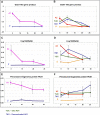The evolution of spinnable cotton fiber entailed prolonged development and a novel metabolism
- PMID: 18248099
- PMCID: PMC2222923
- DOI: 10.1371/journal.pgen.0040025
The evolution of spinnable cotton fiber entailed prolonged development and a novel metabolism
Abstract
A central question in evolutionary biology concerns the developmental processes by which new phenotypes arise. An exceptional example of evolutionary innovation is the single-celled seed trichome in Gossypium ("cotton fiber"). We have used fiber development in Gossypium as a system to understand how morphology can rapidly evolve. Fiber has undergone considerable morphological changes between the short, tightly adherent fibers of G. longicalyx and the derived long, spinnable fibers of its closest relative, G. herbaceum, which facilitated cotton domestication. We conducted comparative gene expression profiling across a developmental time-course of fibers from G. longicalyx and G. herbaceum using microarrays with approximately 22,000 genes. Expression changes between stages were temporally protracted in G. herbaceum relative to G. longicalyx, reflecting a prolongation of the ancestral developmental program. Gene expression and GO analyses showed that many genes involved with stress responses were upregulated early in G. longicalyx fiber development. Several candidate genes upregulated in G. herbaceum have been implicated in regulating redox levels and cell elongation processes. Three genes previously shown to modulate hydrogen peroxide levels were consistently expressed in domesticated and wild cotton species with long fibers, but expression was not detected by quantitative real time-PCR in wild species with short fibers. Hydrogen peroxide is important for cell elongation, but at high concentrations it becomes toxic, activating stress processes that may lead to early onset of secondary cell wall synthesis and the end of cell elongation. These observations suggest that the evolution of long spinnable fibers in cotton was accompanied by novel expression of genes assisting in the regulation of reactive oxygen species levels. Our data suggest a model for the evolutionary origin of a novel morphology through differential gene regulation causing prolongation of an ancestral developmental program.
Conflict of interest statement
Competing interests. The authors have declared that no competing interests exist.
Figures




Similar articles
-
Comparative evolutionary and developmental dynamics of the cotton (Gossypium hirsutum) fiber transcriptome.PLoS Genet. 2014 Jan;10(1):e1004073. doi: 10.1371/journal.pgen.1004073. Epub 2014 Jan 2. PLoS Genet. 2014. PMID: 24391525 Free PMC article.
-
Transcript profiling by microarray and marker analysis of the short cotton (Gossypium hirsutum L.) fiber mutant Ligon lintless-1 (Li1).BMC Genomics. 2013 Jun 17;14:403. doi: 10.1186/1471-2164-14-403. BMC Genomics. 2013. PMID: 23767687 Free PMC article.
-
Parallel expression evolution of oxidative stress-related genes in fiber from wild and domesticated diploid and polyploid cotton (Gossypium).BMC Genomics. 2009 Aug 17;10:378. doi: 10.1186/1471-2164-10-378. BMC Genomics. 2009. PMID: 19686594 Free PMC article.
-
Gene expression changes and early events in cotton fibre development.Ann Bot. 2007 Dec;100(7):1391-401. doi: 10.1093/aob/mcm232. Epub 2007 Sep 27. Ann Bot. 2007. PMID: 17905721 Free PMC article. Review.
-
An Overview of Cotton Gland Development and Its Transcriptional Regulation.Int J Mol Sci. 2022 Apr 28;23(9):4892. doi: 10.3390/ijms23094892. Int J Mol Sci. 2022. PMID: 35563290 Free PMC article. Review.
Cited by
-
A combined functional and structural genomics approach identified an EST-SSR marker with complete linkage to the Ligon lintless-2 genetic locus in cotton (Gossypium hirsutum L.).BMC Genomics. 2011 Sep 9;12:445. doi: 10.1186/1471-2164-12-445. BMC Genomics. 2011. PMID: 21902843 Free PMC article.
-
The Ligon lintless -2 Short Fiber Mutation Is Located within a Terminal Deletion of Chromosome 18 in Cotton.Plant Physiol. 2020 May;183(1):277-288. doi: 10.1104/pp.19.01531. Epub 2020 Feb 26. Plant Physiol. 2020. PMID: 32102829 Free PMC article.
-
Asymmetric subgenome selection and cis-regulatory divergence during cotton domestication.Nat Genet. 2017 Apr;49(4):579-587. doi: 10.1038/ng.3807. Epub 2017 Mar 6. Nat Genet. 2017. PMID: 28263319
-
Integrative Transcriptomic and Metabolic Analyses Reveal That Flavonoid Biosynthesis Is the Key Pathway Regulating Pigment Deposition in Naturally Brown Cotton Fibers.Plants (Basel). 2024 Jul 24;13(15):2028. doi: 10.3390/plants13152028. Plants (Basel). 2024. PMID: 39124145 Free PMC article.
-
Cotton fiber as a model for understanding shifts in cell development under domestication.Front Plant Sci. 2023 Mar 2;14:1146802. doi: 10.3389/fpls.2023.1146802. eCollection 2023. Front Plant Sci. 2023. PMID: 36938017 Free PMC article. Review.
References
-
- Doebley J, Stec A, Hubbard L. The evolution of apical dominance in maize. Nature. 1997;386:485–488. - PubMed
-
- Li CB, Zhou AL, Sang T. Rice domestication by reducing shattering. Science. 2006;311:1936–1939. - PubMed
-
- Konishi S, Izawa T, Lin SY, Ebana K, Fukuta Y, et al. An SNP caused loss of seed shattering during rice domestication. Science. 2006;312:1392–1396. - PubMed
-
- Frary A, Nesbitt TC, Frary A, Grandillo S, van der Knaap E, et al. fw2.2: A quantitative trait locus key to the evolution of tomato fruit size. Science. 2000;289:85–88. - PubMed
Publication types
MeSH terms
Substances
LinkOut - more resources
Full Text Sources
Molecular Biology Databases

